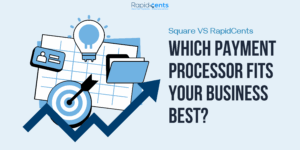POS systems have come a long way from the clunky cash registers of the past. Today, they’re powerful, cloud-based platforms that do more than just process payments; they manage inventory, generate reports, track customers, and connect seamlessly with other business tools.
Whether you’re running a retail store, a restaurant, or an eCommerce brand, POS systems can be the backbone of your operations. They help you serve customers faster, reduce errors, and make smarter decisions with real-time data.
But what exactly is a POS system, how does it work, and what should you look for when choosing one? This guide breaks it down step by step so you can understand the essentials before investing in your business growth.
What is a POS System?
A Point of Sale (POS) system is the combination of hardware and software that allows businesses to accept payments, record sales, and manage day-to-day operations. In simple terms, it’s the place where a customer completes a transaction, whether that’s at a retail counter, a restaurant table, or a pop-up store.
The Modern Definition of POS
In the past, POS systems were little more than cash registers. Today, they’ve evolved into full business management platforms. A modern POS doesn’t just handle credit cards or debit cards; it can also process digital wallets, track inventory in real time, and provide insights through detailed reporting dashboards.
For Canadian businesses, point of sales systems are especially important because they need to handle chip-and-PIN debit (Interac), contactless tap payments, and cross-border transactions in both CAD and USD. That makes a reliable POS system more than just a payment tool; it’s a central hub for customer experience and financial management.
Why Businesses Need a POS System
Without a POS, many businesses rely on manual processes or outdated systems that slow them down. A POS system brings:
- Efficiency: Faster checkout and smoother service.
- Accuracy: Fewer errors with digital tracking and automated reporting.
- Insights: Real-time data on sales, customers, and inventory.
- Flexibility: Ability to accept multiple payment methods, including online and mobile.
How Does a POS System Work?
A POS system allows you to accept payments from customers and track the sales of your store or business. Nowadays, point of sales systems also allow you to track every purchase and customer from anywhere and manage multiple locations from one dashboard.
Depending on the features and POS terminal you choose, it can allow you to access and control more information across your business. The basic working of every POS terminal is as follows:
1. Customer Chooses the Product or Service
Once your customer chooses the service or product in the store, they will go to the front desk and ask for the sale to be completed. This will be done by either scanning a barcode, choosing the product from a menu on the POS, or entering the details manually.
2. Payment is Initiated
The customer will then have the option to choose their payment method, including credit card, debit card, mobile wallet, or gift cards.
3. Authorization Takes Place
The customer will then complete the purchase by tapping or inserting their card or whatever payment method they choose. The payment will be authorized by the customer’s bank.
4. Once the Transaction is Completed
Once the payment is approved by the bank, the purchase will be complete, and a digital or printed receipt will be generated. The sales records, inventory, and customer details will also be updated automatically in the POS database.
POS Hardware vs. Software Components
POS Hardware
Depending on your business type, this may include terminals, card readers, barcode scanners, receipt printers, cash drawers, and tablets.
POS Software
The engine behind the system. POS software manages payments, connects with accounting tools, tracks inventory, and provides sales analytics.
For many modern businesses in Canada and beyond, cloud-based POS software is the preferred choice. It allows you to log in from anywhere, update prices in real time, and scale as your business grows, all while keeping transaction data secure and compliant.
Types of POS Systems
Not all POS are the same. The right fit depends on your business, the size, and how you serve your customers. These are the main types of POS:
- Traditional POS
These are on-premise POS systems that require physical servers. They are installed locally and usually involve higher upfront costs. The setup includes computers, barcode scanners, cash registers, etc.
- Cloud POS
Cloud POS systems run on the internet and store data securely in the cloud. They can be accessed from any device and updated in real time. Cloud POS ensures pricing, promotions, and inventory stay consistent everywhere. They ideally have a low setup cost and are good for scalability.
- Mobile POS (mPOS)
Mobile POS systems turn smartphones or tablets into checkout counters with the help of a card reader. They’re popular among small businesses, seasonal vendors, and service professionals who need to accept payments on the go.
- Retail POS
Designed for product-based businesses, retail POS systems typically include barcode scanning, inventory tracking, and customer loyalty tools. They’re built to handle higher transaction volumes and multiple inventory items.
- Self-Checkout POS
Often found in supermarkets and fast-food chains, they allow customers to place their orders and complete payments on the system by themselves. They help increase checkout speed with less staff assistance.
- Omnichannel POS for Hybrid Businesses
As online and in-store experiences blend, omnichannel POS systems let businesses manage sales across physical shops, eCommerce sites, and mobile apps in one place. They are ideal for businesses that have physical and digital stores, such as clothing and shoe brands.
Core Features of a POS System
A modern POS system goes far beyond payment processing. The right platform helps manage your entire business, no matter where you are. Here are the core features to look for:
- Payment Processing
At its foundation, a POS must securely accept payments. Today’s systems handle credit and debit cards, contactless tap (NFC), chip-and-PIN, mobile wallets like Apple Pay and Google Pay, and even gift cards.
- Inventory Management
Track and keep count of products in real-time based on purchases across all stores. Advanced POS systems can be set up to send low-stock alerts. Automate purchases and manage all information across multiple locations.
- Sales Reporting & Analytics
POS systems provide detailed reports on daily sales, peak hours, best-selling products, and staff performance. This data helps business owners make smarter decisions, whether it’s adjusting menu items in a restaurant or stocking seasonal products in retail.
- Customer Management & Loyalty Tools
Modern POS systems often include CRM features to collect customer information, track purchase history, and run loyalty programs. This makes it easier to personalize promotions and reward repeat business.
- Staff Management
POS systems can assign user roles, maintain schedules, track employee hours, and monitor performance. They also allow businesses to keep track of all employees across numerous locations.
Benefits of Using a POS System
Getting advanced POS systems is not just about staying in touch with the latest technology. It allows businesses to run smoothly, reduce manual tasks, and manage data across the entire business, leading to smarter decisions and faster growth.
- Faster Checkout & Better Customer Experience
A POS system makes transactions quicker and creates digital receipts. It also gives the customers the liberty to choose from multiple payment methods.
- Improved Accuracy & Reduced Errors
Manual entries can lead to errors, but with a POS system, the entire process can be automated. This reduces erosion in recorded sales, inventory count, and even receipts.
- Real-time Inventory Tracking
Instead of guessing what’s in stock, a POS system gives you live visibility. You can see exactly how many units are left, set automatic reorders, and track performance across multiple locations.
- Smarter Business Decisions With Analytics
POS data reveals trends you might miss. This could include identifying peak hours for cafes or the best products being sold by a brand. These insights help businesses optimize staffing, pricing, and promotions.
POS System Costs Explained
The cost of a POS system is not fixed and can vastly depend on your business size, industry, and the features you need. Here’s a breakdown of what to expect:
Hardware Costs
-
- Terminals and card readers: Essential for processing payments.
- Barcode scanners and receipt printers: Common in retail environments.
- Tablets or registers: Often used as the main POS screen.
- For restaurants and retail stores in Canada, hardware bundles can range from a few hundred dollars to several thousand, depending on scale.
Software & Subscription Pricing
-
- Most modern POS systems operate on a subscription model.
- Businesses pay a monthly fee for access to features such as reporting, inventory, and customer management.
- Entry-level plans may start small, but costs rise with advanced features or multi-location support.
Payment Processing Fees
-
- Every POS system connects to a payment processor. Each transaction comes with a fee, typically a small percentage of the sale plus a fixed cost.
- For Canadian businesses, this often includes debit fees and credit card processing charges.
Hidden Costs to Watch Out For
-
- Setup and installation: Some providers charge one-time setup fees.
- Support and training: Premium support or on-site training may add costs.
- Add-ons and integrations: Features like loyalty programs, delivery integrations, or advanced reporting often come at an extra price.
POS Security & Compliance
Security is one of the most critical factors in choosing a POS system. Since POS platforms handle sensitive data, including payment card details and customer information, they must be designed with safeguards that protect both businesses and consumers.
- Data Encryption
End-to-end encryption helps protect payment details from the moment the card is swiped. Tapped or inserted. This ensures that sensitive data never travels in plain text, reducing the risk of fraud.
- PCI DSS Compliance
Many POS systems include built-in fraud detection tools. Suspicious transactions, such as repeated declines or unusually high-value purchases, can trigger alerts, giving businesses a chance to intervene before losses occur.
- User Permission and Access
Role-based permissions allow business owners to control who can access certain features. For example, cashiers may only process sales, while managers can generate reports or issue refunds. This minimizes internal fraud risks.
- Fraud Detection and Alerts
Many POS systems include built-in fraud detection tools. Suspicious transactions, such as repeated declines or unusually high-value purchases, can trigger alerts and lock the systems, giving businesses a chance to intervene before losses occur.
POS System Integrations
One of the biggest advantages of POS systems is their ability to integrate with other business tools such as accounting, e-commerce, and customer management platforms. This enables businesses to manage data across various tools without manual input, saving time and reducing errors.
- Payments & Gateways
Seamless integration with payment gateways allows businesses to accept a wide range of payment methods. From credit cards and Interac debit to Apple Pay, Google Pay, and PayPal, integrated payments make checkout flexible and customer-friendly.
- Accounting Software
Integrating your POS with accounting tools like QuickBooks or Xero ensures every sale, tax, and refund is automatically logged. This eliminates manual entry, reduces bookkeeping errors, and makes tax time far easier.
- eCommerce Platforms
For businesses that sell both online and in-store, POS systems that integrate with platforms like Shopify, WooCommerce, or BigCommerce make management easier. Inventory levels sync automatically, preventing overselling and ensuring consistency across all channels.
- CRM & Loyalty Programs
By connecting with CRM tools, a POS can track purchase history, customer preferences, and loyalty program activity. This allows businesses to create personalized marketing campaigns, offer targeted promotions, and strengthen customer retention.
Choosing the Right POS System for Your Business
With so many options on the market, selecting the right POS system can feel overwhelming. The key is to match the system’s strengths with your industry needs and long-term goals.
POS for Retail Businesses
Retailers often juggle high product volumes and multiple sales channels. The best retail POS systems include:
-
- Barcode scanning and fast checkout.
- Real-time inventory tracking across locations.
- Loyalty programs to reward repeat customers.
- Omnichannel integration with eCommerce platforms.
POS for Restaurants & Hospitality
Restaurants and cafés need POS systems designed for speed and flexibility. Must-have features include:
-
- Table and order management.
- Split billing and tipping options.
- Menu customization and quick item modifiers.
- Integration with food delivery apps.
POS for Service-Based Businesses
For salons, fitness studios, and other service businesses, POS systems should focus on customer convenience. Key features are:
-
- Appointment scheduling and booking.
- Membership or subscription billing.
- Mobile POS support for on-the-go transactions.
- CRM integration to track client history.
Questions to Ask Before Buying
Before committing to a POS provider, ask:
-
- Does it support the payment types my customers prefer (credit, debit, mobile wallets)?
- Can it scale as my business grows?
- What reporting tools are included?
- How transparent are the fees (hardware, software, processing)?
- Is customer support available when I need it?
The Future of POS Systems
Point of Sale technology continues to evolve rapidly, driven by changing customer expectations and advances in digital payments. Businesses that embrace these trends will stay competitive and deliver better experiences.
- Artificial Intelligence and Automation
AI is becoming a powerful part of POS systems. From predictive inventory management to automated upselling prompts at checkout, AI helps businesses optimize operations and increase revenue without extra manual work.
- Contactless and Mobile-First Experiences
Customers are moving away from cash and even traditional cards in favor of tap, mobile wallets, and QR code payments. In Canada, where Interac contactless transactions are already mainstream, this trend will only accelerate.
- Omnichannel Commerce Trends
The line between online and offline shopping is blurring. Future POS systems will continue to unify in-store, eCommerce, and mobile channels. Thai will give businesses one platform to manage sales, inventory, and customer relationships across all touchpoints.
Conclusion
A POS system is far more than just a way to accept payments. It helps you serve customers faster, track inventory in real time, generate valuable insights, and scale with confidence.
As payment technology continues to evolve, businesses that invest in a reliable POS solution will stay ahead of the curve and deliver experiences their customers expect.
Ready to streamline your payments? Explore our POS solutions today.
Get in touch




